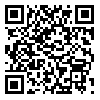Volume 14, Issue 6 (2018)
ioh 2018, 14(6): 126-134 |
Back to browse issues page
Download citation:
BibTeX | RIS | EndNote | Medlars | ProCite | Reference Manager | RefWorks
Send citation to:



BibTeX | RIS | EndNote | Medlars | ProCite | Reference Manager | RefWorks
Send citation to:
heydari P, varmazyar S, jafarvand M, alizadeh S, hakimi C. Predicting maximum oxygen consumption based on anthropometric dimensions in medical emergency students . ioh 2018; 14 (6) :126-134
URL: http://ioh.iums.ac.ir/article-1-1983-en.html
URL: http://ioh.iums.ac.ir/article-1-1983-en.html
, svarmazyar@qums.ac.ir
Abstract: (3881 Views)
Background and aims: Body anthropometric dimensions are among the factors affecting the maximum oxygen consumption. This study aimed to predict maximum oxygen consumption based on anthropometric dimensions in medical emergency students.
Methods: This cross-sectional analytical study was conducted among 56 medical emergency students from Qazvin University of medical sciences. Initially, physical activity readiness Questionnaire (PAR-Q) was applied to ensure the full health of participants to inter the study. Maximum oxygen consumption measured using Gerkin treadmill test. Anthropometric dimensions were measured by tape measure, anthropometer and kolis. Obtain data was analyzed by Pearson product moment correlation and multiple linear regressions in SPSS 19 software.
Results: The mean age of participants was 21.69 years. The mean of maximum oxygen consumption and mean of foot length estimated 4.17 L/min and 96.35 cm, respectively. There was significant correlation between the maximum oxygen with the anthropometric dimensions. Variables of dimensions of abdomen circumstance, foot length and leg circumstance predicted 63.7 percent of the maximum oxygen consumption.
Conclusion: The results indicated that the anthropometric dimensions are the factors affecting the maximum oxygen consumption among medical emergency student. So, it is necessary to be paid attention to anthropometric dimension in selection of students and matching between person capabilities with energy.
Methods: This cross-sectional analytical study was conducted among 56 medical emergency students from Qazvin University of medical sciences. Initially, physical activity readiness Questionnaire (PAR-Q) was applied to ensure the full health of participants to inter the study. Maximum oxygen consumption measured using Gerkin treadmill test. Anthropometric dimensions were measured by tape measure, anthropometer and kolis. Obtain data was analyzed by Pearson product moment correlation and multiple linear regressions in SPSS 19 software.
Results: The mean age of participants was 21.69 years. The mean of maximum oxygen consumption and mean of foot length estimated 4.17 L/min and 96.35 cm, respectively. There was significant correlation between the maximum oxygen with the anthropometric dimensions. Variables of dimensions of abdomen circumstance, foot length and leg circumstance predicted 63.7 percent of the maximum oxygen consumption.
Conclusion: The results indicated that the anthropometric dimensions are the factors affecting the maximum oxygen consumption among medical emergency student. So, it is necessary to be paid attention to anthropometric dimension in selection of students and matching between person capabilities with energy.
Type of Study: Research |
Subject:
Ergonomics
Received: 2016/12/15 | Accepted: 2017/12/2 | Published: 2018/04/7
Received: 2016/12/15 | Accepted: 2017/12/2 | Published: 2018/04/7
Send email to the article author
| Rights and permissions | |
 |
This work is licensed under a Creative Commons Attribution-NonCommercial 4.0 International License. |





